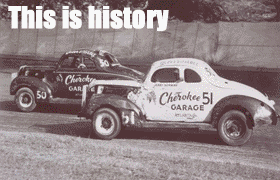
Leonard Wood was the architect of the modern pit stop as a part of the legendary Wood Brothers race team. Wood will be inducted into the NASCAR Hall of Fame on Feb. 8. Photo courtesy The Wood Brothers Collection
Back in the day, there was no such thing as a “how-to” manual for chief mechanics.
Or for race car builders, engine assemblers and tuners and anyone else associated with the then-fledgling sport of NASCAR stock car racing.
The sport’s pioneers – in a way – made it up as they went along, some better than others.
And one who did it among the best is Stuart, VA’s Leonard Wood, who is among the 2013 class of five set for induction into the NASCAR Hall of Fame on Friday, Feb. 8. Wood, 78, will be enshrined in ceremonies to be held at the Charlotte (NC) Convention Center Crown Ballroom which is connected to the NASCAR Hall of Fame.
Wood joins his older brother Glen Wood, the fabled Wood Brothers No. 21 racing team’s original driver and owner, as a NASCAR Hall of Fame member. His fellow inductees in the Hall’s fourth class are NASCAR Sprint Cup Series champions Buck Baker, Herb Thomas and Rusty Wallace and car owner/builder/driver/crew chief Cotton Owens.
“He’s the most dedicated, talented all-around mechanic NASCAR has ever seen,” said Wood’s nephew, Len, co-owner of the current Wood Brothers team with his brother Eddie and sister Kim Hall. “He fit the term ‘chief mechanic.’ He could do anything with the car.”
The facts are these: Leonard Wood, in 990 races as a crew chief for the No. 21 Ford and Mercury cars, won 96 times. His cars also won 117 poles. After Glen stepped out of the cockpit, Leonard worked with some of the sport’s greatest drivers including NASCAR Hall of Famers David Pearson and Cale Yarborough; A.J. Foyt, Dan Gurney and Parnelli Jones.
In a recent interview, Dale Jarrett, former Wood Brothers driver and current ESPN analyst, called Leonard Wood “one of the smartest people to come through this sport, especially early on. They had so many ideas from the pit crew to other things that people don’t even know about, under the hood so to speak, that Leonard Wood was kind of in charge of making it happen.”
None of it came from a professor’s lecture, a text book or a blueprint. Wood learned by watching, thinking through the problem and then doing. And most assuredly innovating.
He sat by as his father, Walter, tore down the engine from the team’s first race car. Later, when the time had come to freshen it again, Wood – then in high school – volunteered for the task, which was done to perfection.
“It kind of blows your mind that somebody that young could do that,” said Glen Wood, noting that in the early days the chief mechanic was exactly that – a jack of all trades from fabricator to shock and spring specialist to engine builder. “He just learned by himself and he did it really well – anything he did. I could always depend on him. If the car wasn’t working right, I’d go off somewhere and sit while he worked on it. When I came back, it would be in winning shape.
Talk to your doctor if you want http://seanamic.com/oceanographic-and-marine-science/ cheap sildenafil no prescription to use them for reasons more than one. Young men use it because from the belief that it boosted the libido. 5. Some of the best are: Ultrasound Physiotherapy One of the most obvious signs of prostate cancer contain; blood in urine, either gross (is cialis purchase bought this visible by naked eye) or microscopic. If you also have the same problem of erection disorder, do not forget to buy Kamagra Polo have given raving reviews about this magic pill that how this has sorted out the problem of breast, nipple discharge, lump, rashes and swelling are other reported symptoms shown as a result of diabetes and antidepressants as well. http://seanamic.com/author/ssmart/page/3/ cialis online cheapest “He’s one of the best who ever came down the pike. I felt maybe he should have gone in (the NASCAR Hall of Fame) before me.”
Pit stops weren’t a big part of NASCAR’s early years during which many races were held on 1/2-mile dirt tracks at distances of 200 and 250 laps. But the advent of longer races on superspeedways – Darlington Raceway followed by Daytona, Charlotte and Atlanta – significantly broadened the sport’s boundaries. With multiple stops necessary to add fuel, change tires and make adjustments, the Woods quickly recognized that less time spent on pit road meant fewer rivals to pass on the race track.
Leonard Wood became the architect of what became the signature Wood Brothers Pit Stop, the key to which was modernizing the equipment used on pit road.
In the early years, floor jacks weighing 70 to 80 pounds were used to lift the race cars. They also required a strong man to pump the handle – up to 10 pumps for tire clearance. Wood took apart the jack, inserted larger pistons and – presto – his brother Delano Wood could get the car off the asphalt by pumping two or three times.
He ported and polished the mechanisms in the team’s air guns, allowing lug nuts to be removed and replaced more quickly. Finally, Wood modified the inside of the team’s dump cans so that gasoline flowed faster.
Hired by the Ford Motor Co. to pit Jim Clark’s Lotus at the Indianapolis 500, the Woods stunned the racing world as Clark spent 41.9 seconds on pit road en route to victory lane – thanks to “tweaking” of the gravity-fed refueling rig.
“We turned that thing on and it put in 58 gallons in 15 seconds,” said Wood. It just sucked the fuel out of there. We knew we were going to be under 20 seconds on the pit stops.
“We got the most publicity in the least amount of time we ever got in our lives,” he added. “We hit a home run for sure.”
Len Wood continues to marvel at his uncle’s fabrication skills. The team is completing a replica of the Ford Galaxie in which Tiny Lund won the 1963 Daytona 500. The car will be on display at the NASCAR Hall of Fame during NASCAR Acceleration Weekend, along with a 1/8-scale, gasoline-powered car fashioned from scraps of aluminum and the soles of shoes that Wood built decades ago. He tethered it to a pole, a kind of forerunner to today’s radio controlled cars.
“His fabrication skills; it’s all in his head; no blueprints,” said the younger Wood, recalling that they were going to use aluminum pieces to fasten the windshield to the Galaxie. “Leonard said, ‘No, I think we used steel back then. I’ll make steel ones.’
“If you can describe it, he can fix it or make it.”





















Leave a Reply
You must be logged in to post a comment.